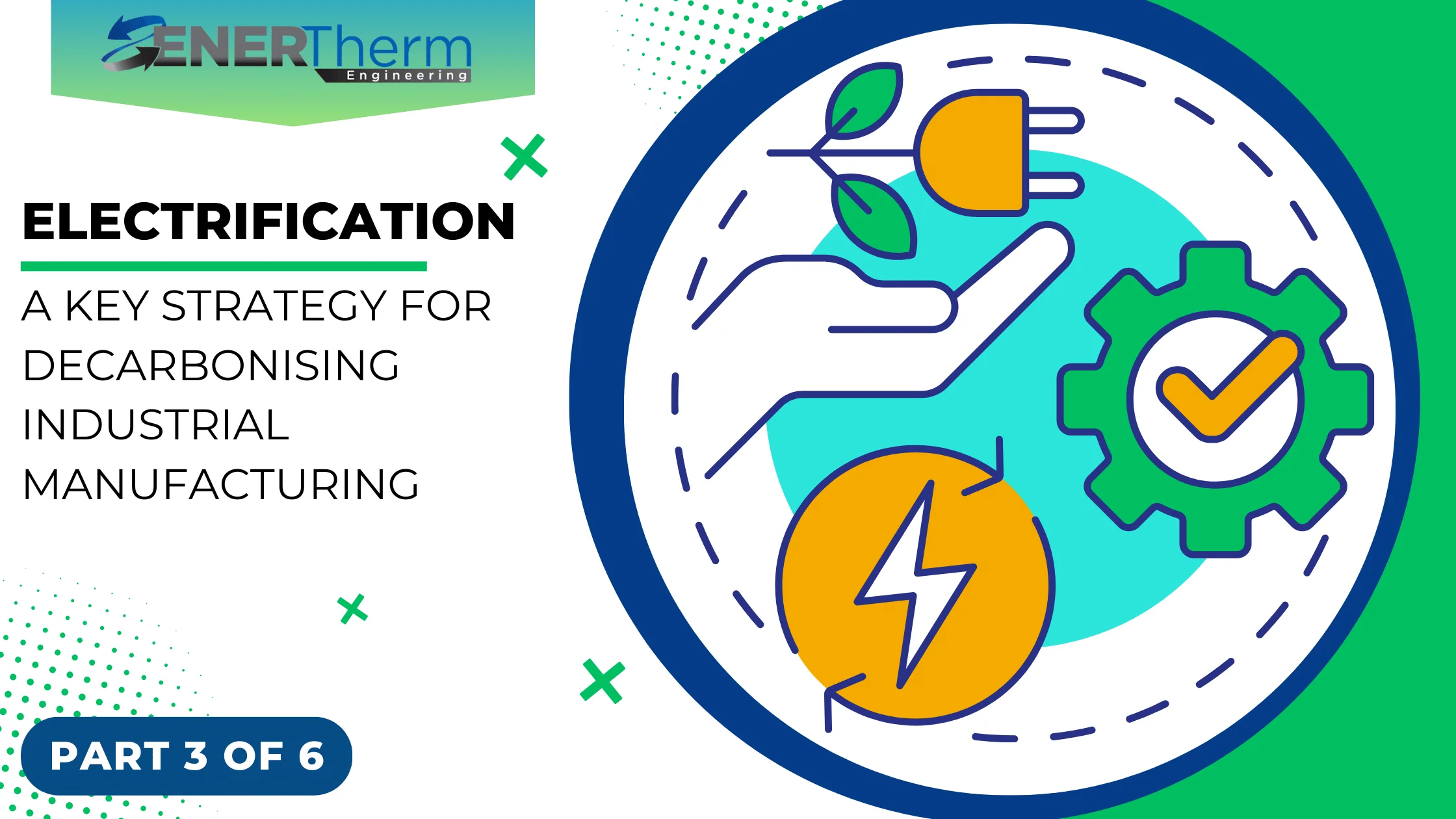What is electrification and what is it used for in industrial manufacturing?
Electrification is the process of replacing fossil-fuel-based energy sources with electricity from renewable sources, such as wind or solar. Electrification can reduce emissions by avoiding the combustion of fossil fuels, which produce greenhouse gases and air pollutants.
Electrification can be used for various purposes in industrial manufacturing, such as:
- Powering electric heating systems, which use electricity to generate heat for industrial processes or buildings, such as electric boilers, electric furnaces, electric heat pumps, or electric infrared heaters.
- Powering electric motors, which use electricity to drive mechanical devices for industrial processes or equipment, such as electric pumps, electric fans, electric compressors, or electric conveyors.
- Powering electrochemical processes, which use electricity to induce chemical reactions for industrial products or services, such as electrolysis, electroplating, electrowinning, or electrorefining.
How efficient is electrification for industrial manufacturing?
The efficiency of electrification for industrial manufacturing depends on various factors, such as the type of electricity generation, the transmission and distribution losses, and the end-use efficiency.
- The type of electricity generation refers to the method of converting primary energy sources, such as coal, natural gas, nuclear, wind, or solar, into electricity. The type of electricity generation affects the efficiency and emissions of electrification, depending on the fuel mix and the carbon intensity of the electricity grid. The more renewable and low-carbon sources are used for electricity generation, the more efficient and less emissive electrification becomes.
- The transmission and distribution losses refer to the amount of electricity that is lost during its transport from the power plants to the end-users, due to resistance, leakage, or theft. The transmission and distribution losses reduce the efficiency and increase the emissions of electrification, depending on the distance and the quality of the electricity grid. The shorter and more reliable the electricity grid is, the lower the transmission and distribution losses are.
- The end-use efficiency refers to the amount of useful output that is obtained from a given amount of electricity input, by an industrial process or equipment. The end-use efficiency affects the efficiency and emissions of electrification, depending on the type and design of the electric heating system, electric motor, or electrochemical process. The higher the end-use efficiency is, the lower the electricity consumption and emissions are.
According to a study by McKinsey & Company , electrification could increase the energy efficiency of industrial manufacturing by 10% to 30%, compared to conventional fossil-fuel-based systems. This is because electric heating systems, electric motors, and electrochemical processes have higher end-use efficiencies than their fossil-fuel-based counterparts.
Example: Improving Efficiency in Edible Oil Heating
To further illustrate these points, let’s consider the process of heating edible oil for a frying system, a common industrial process.
Traditionally, natural gas or diesel has been the preferred source of energy for heating the oil in these systems. These methods typically have an energy efficiency of around 80%. This means that 20% of the energy from the fuel is lost to the surroundings, or not utilized in the actual heating of the oil.
On the other hand, if we replace these traditional fuels with electricity, the efficiency of the heating process can rise up to around 95%. This high rate of efficiency is attributable to the fact that electric heaters can convert almost all of the incoming electric power to heat, with minimal losses. The heating is also more uniform and easier to control, which contributes to further efficiency gains in the overall process.
Therefore, using electricity instead of natural gas or diesel can result in a significant improvement in energy efficiency for heating edible oil in a frying system, reducing both the energy costs and the environmental impacts. This is just one of many examples of how electrification can potentially improve the energy efficiency of industrial manufacturing processes.
What are the pros and cons of electrification for industrial manufacturing?
Electrification has several advantages for industrial manufacturing, such as:
- Reducing emissions, by avoiding the combustion of fossil fuels, which produce greenhouse gases and air pollutants.
- Enhancing energy security and resilience, by reducing the dependence on imported fossil fuels, and increasing the diversity and reliability of energy sources.
- Improving productivity and quality, by providing more precise and consistent control over industrial processes or equipment, and reducing maintenance and downtime.
However, electrification also has some disadvantages for industrial manufacturing, such as:
- Increasing grid capacity requirements, by adding new and large loads to the electricity grid, which may exceed its current capacity and stability.
- Facing demand management challenges, by having to cope with variable and intermittent supply from renewable sources, and peak demand from industrial users.
- Questioning cost-effectiveness, by having to compare the upfront and operating costs of electrification with those of conventional systems, and taking into account the externalities and subsidies. An example here can be seen with electric heating equipment. The higher the voltage and the smaller the size of the heater, the lower the capital cost. Likewise, a higher voltage also reduces the size of the electrical cable required, subsequently decreasing installation costs. However, an increase in voltage may necessitate the upsizing of transformers, which could potentially offset these savings.
- Lacking policy support, by having to deal with regulatory uncertainty, market distortion, and consumer resistance.
How much can electrification contribute to net zero and decarbonisation goals for industrial manufacturing?
Electrification can contribute significantly to net zero and decarbonisation goals for industrial manufacturing, by reducing the emissions from fossil-fuel-based systems. According to McKinsey & Company , electrification could cut global CO2 emissions from industrial manufacturing by 2.7 gigatons per year by 2050, compared to a business-as-usual scenario. This would represent a 27% reduction in industrial emissions, and a 6% reduction in global emissions.
The potential contribution of electrification to net zero and decarbonisation goals for industrial manufacturing depends on various factors, such as the availability and cost of renewable electricity, the development and deployment of low-carbon industrial processes, the adoption and diffusion of electrification technologies, and the policy support and incentives for electrification projects.
According to McKinsey & Company , electrification could constitute approximately 25% of cumulative CO2 emissions reductions in industry by 2050, compared to a business-as-usual scenario. This would require a rapid increase in the deployment of electrification projects, from 100 megatons per year in 2020 to 500 megatons per year in 2030, and to 2,700 megatons per year in 2050. This would also require a significant increase in the installed capacity of electrification, from 100 megawatts in 2020 to 500 megawatts in 2030, and to 2,700 megawatts in 2050.
Are electrification future proof for industrial manufacturing?
Electrification is likely to be future proof for industrial manufacturing, as it can provide a low-carbon and cost-effective solution for replacing fossil-fuel-based systems. However, there are some challenges and uncertainties that need to be addressed, such as:
- Technological advancements, which are needed to improve the efficiency, performance, reliability, and durability of electrification technologies, as well as to reduce their costs, noise, and environmental impacts.
- Policy frameworks, which are needed to create a favourable regulatory environment, provide financial support, remove market barriers, and raise awareness and confidence among industrial users and stakeholders.
- Consumer preferences, which are needed to stimulate the demand and supply of electrified products or services, as well as to ensure their quality, safety, and sustainability.
- Grid integration, which is needed to ensure the availability and stability of electricity supply for electrification projects, as well as to enable demand response and load management.
To ensure that electrification is future proof for industrial manufacturing, it is important to foster collaboration and coordination among different actors, such as policy makers, industry associations, manufacturers, suppliers, researchers, and end-users. It is also important to monitor and evaluate the performance and impacts of electrification projects, and to share best practices and lessons learned. By doing so, electrification can play a key role in achieving net zero and decarbonisation goals for industrial manufacturing.

